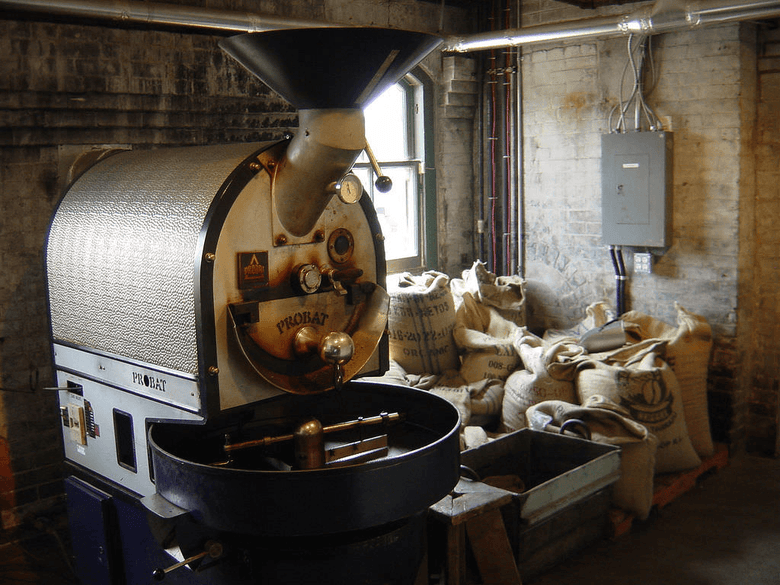There are many steps in the journey from fruit to brewed coffee, but today we’ll just focus on one: the coffee roaster. This blog is for anyone who’s ever asked himself: “what does a coffee roaster actually do?”
If you’ve ever seen a coffee roaster in action, you know that it’s not a tame, simple process. It’s complex, requires precise equipment, and includes - for the best of them - a lot of science. There are no assembly lines, no factory equipment. Coffee roasters are craftsmen and scientists who want to do right by their farmers, customers, and coffee.
There’s a lot that happens behind the scenes that us regular coffee lovers don’t get to see or be a part of.
That’s what this article is about: reaching into the work of coffee roasters so that we can appreciate them, and our coffee, on a new level.
Read: The Incredible Journey Of The Coffee Bean (Seed To Cup)
Coffee Comes From Around The World
Coffee’s not made in a plant; it grows in a plant. It’s the seed of the coffee shrub, to be precise. It’s planted, cared for, harvested, processed, and packaged before it even gets to the roaster. All of these first steps (the most important ones!) happen overseas.
Coffee roasters have to find this coffee and somehow, try and buy it. Here are a few ways they do so.
Warehouse / Catalogue Sales - The chief method of sourcing for several decades, ordering green coffees from an importer only required the roaster to order a catalog or visit a warehouse. Sometimes samples were available, but the authority was given to a licensed Quality Grader to grade and price the coffees. This type of sourcing has been revolutionized by the internet, and is now much more quality-centric than it was in the past.
Direct Trade - Roasters travel to visit the farms in this sourcing model. They shake the hands of the farmers, inspect the land, and get to try the coffee in the region it was grown. Roasters get to eliminate the catalogue or warehouse middleman and make deals that are better for the roaster and farmer.
Both of these methods have their advantages and flaws, but one has risen in popularity in the world of specialty coffee: direct trade.
Read: Fair Trade VS Direct Trade Coffee: Which Is Better For Coffee Sustainability?
Roasters And Global Relationships
Direct trade is about making relationships around the world. If money was the only goal, roasters would simply order coffees with high scores on the internet (totally possible). But specialty coffee roasters think bigger.
One of the specialty coffee companies at the forefront of ethical sourcing is Intelligentsia Coffee and Tea in Chicago. Their direct trade criteria requires them to buy coffees for at least 25% more than the Fair Trade price. Considering that the Fair Trade certification is already about bringing fair wages to farms, companies like Intelligentsia are doing more than just making money. They are impacting the world.
Great roasters know the poverty of the farms they buy coffee from, and they want to do something about it. They learn, they listen, and they invest in the efforts of local communities they source from by purchasing the coffees at generous rates and helping the locals find the resources they need to develop clean water, education, healthcare, and beyond.
Direct trade is about partnership, friendship, and making the world a better place through responsible and globally-conscious sourcing. The specialty roaster down the street doesn’t just put coffee beans into a hot machine. He works with his partners and friends around the world.
Goes In Green, Comes Out Brown
Here’s the most obvious thing roasters do: they apply heat to coffee beans.
Roasting is not so simple as throwing a bucket of green coffee beans into a big machine, letting them swirl around for a bit, then dumping the roasted coffee out. No, it’s much more than that.
Read: The Difference Between Light, Medium, And Dark Roast Coffee
First, there’s planning out the roasting cycles. Since roasted coffee only has 2 to 3 weeks of peak freshness, the roaster has to be very careful about roasting just the right amount of coffee, which requires weeks of planning and careful attention to the green coffee supply. If you’ve seen the back warehouse of a roaster’s facility, you know how much organization and structure it takes to run this side of the business successfully.
Then comes the actual roasting.

The Science of Roasting
There are hundreds of chemical reactions that take places within the 10 or 15 minutes it takes to roast a batch of coffee, and controlling these can be quite difficult. Small changes in temperature, humidity, airflow, and time can make dramatic changes to the final cup, so roasters have to be very precise with their roasting routine and environment.
To find just the right roasting recipe, roasters often perform a few sample roasts in a smaller machine that mimics their regular commercial-sized one. They write down the time, temperature, and other variables to get a close look at what’s happening inside.
Roasters then generally wait 12 - 24 hours after these sample roasts are complete before testing the coffees for quality. When they do the tasting, called ‘coffee cupping’, they take rigorous notes, carefully assessing the flavors, acidity, sweetness, bitterness, aftertaste, body, and aroma. It’s an intense process.
Read: Learn How To Taste Coffee
Once the roaster has identified his favorite of the batch, he does it all over again - sometimes more than once or twice - in order to get the coffee just right before moving to commercial-sized batches to send to stores, coffee shops, and home brewers.
The Art of Roasting
If you drink coffee from one roaster regularly, then switch to another roaster for a long period of time, you’ll notice something peculiar.
Coffees take on the personalities of their roasters.
Allow me to explain.
Oak Cliff Coffee Roasters is based in Dallas, Texas. Shannon generally roasts his coffees to be well-rounded and sweet with a medium body. His flavor descriptors are not terribly specific, but always well chosen. This roast style is stunningly delicious to Folgers drinkers and quite enjoyable to the seasoned specialty coffee professional.
Evocation Coffee Roasters is based in Amarillo, Texas. Roman’s coffees are typically more complex, but less robust than Shannon’s coffees. His flavor descriptors can be quite strange, but just as carefully chosen as Shannon’s. There’s more nuance flavor, but the roast profiles can scare some people away by being too ‘weird’.
There is a clear style difference between the two coffee roasters. Shannon’s value of “delicious but approachable” can be tasted in his coffee when compared to Roman’s goal of “complex and subtle”.
These are two very skilled and highly celebrated coffee roasters, but they aren’t just focused on roasting science numbers all day long, they see their coffee, to some degree, as an expression of their values and personality.
Roasting is an art as much as it is a science.
Investing In The People
Coffee roasters are scientists, craftsmen, artists, but they are also neighbors, friendly faces, and warm embraces. They love their craft, but also want to share it with others. The best way for them to do that is to invest in the people around them.
Like we’ve already talk about, roasters love when international relationship blossoms to the point of contributing to the lives of farming communities in life-altering ways. Contributing towards local efforts to build schools, clinics, and wells is the pride of many roasters, including the ones mentioned in this post.
Read: 3 Reasons Buying Cheap Coffee Is Bad For The World
Great roasters also love to empower people in their hometowns by publishing transparent information on their coffee sources, telling the stories of farmers around the world, and helping people refine their coffee brewing skills.
Roasters are the bridge between the farmer in the coffee forest of Ethiopia and the regular folks enjoying his coffee in a coffee shop somewhere. Roasters are the window by which we get a glimpse of life beyond our context and culture.
The most important investment in a roaster makes is in his effort to bring people and cultures from around the globe together over a great cup of coffee.
---
Coffee roasters that accomplish the things we’ve talked about are heroes. Not because they are knights in shining armor to poor farmers or because they are the guardians of coffee roasting secrets (they are neither of those, and great coffee roasters never put themselves on such a false pedestal).
They are heroes because they, for one, provide us with stellar coffee, and two, help us gain perspective beyond our own context and circumstances.
Happy brewing!
Featured Image Source: Aaron Gustafson


